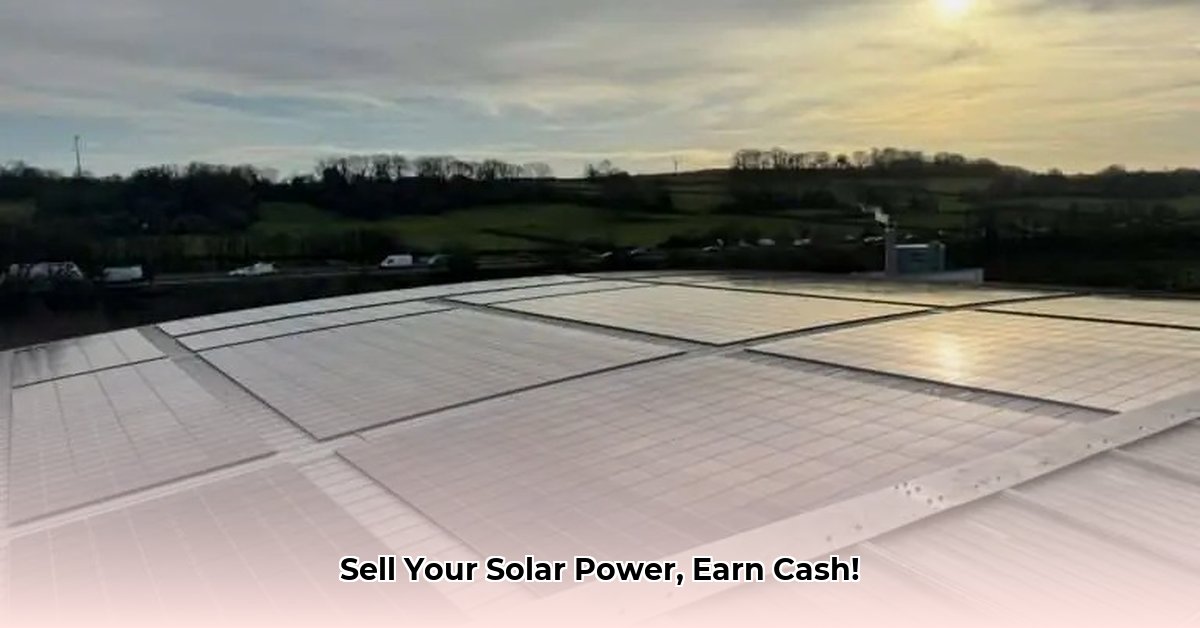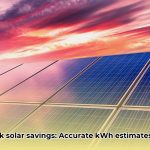Got solar panels and want to make some extra cash? You can! This guide shows you how to sell your extra solar energy using the UK’s Smart Export Guarantee (SEG) scheme. We’ll break down everything step-by-step, so you can easily compare energy companies, understand the process, and start earning money from your sunny investment. Think of it as a simple way to turn your green energy into a bit of green in your wallet. To understand daily solar panel output, check out this helpful resource on [daily solar energy production](https://txgenco.com/how-much-energy-do-solar-panels-produce-per-day). We’ll cover everything you need to know, making the whole thing straightforward and easy to follow. Let’s get started!
Can You Sell Excess Energy From Solar Panels UK? Unlock Solar Profits
Thinking about making some extra cash from your solar panels? It’s entirely possible! Let’s dive into how you can turn that sunshine into pounds in the UK. The key is understanding and participating in the Smart Export Guarantee (SEG) scheme, a financial opportunity that rewards you for contributing to a greener grid.
Understanding the Smart Export Guarantee (SEG): Turning Surplus Energy into Cash with Export Tariffs
The SEG is a UK government program designed to reward you for the extra electricity your solar panels generate that you don’t use. Essentially, your solar panels produce energy, you use what you need, and the rest flows back into the national grid. The SEG ensures you get paid for that extra energy, turning your home into a mini power plant and helping the UK meet its renewable energy targets
Imagine your solar panels as a mini power station on your roof. When they’re producing more electricity than your home’s using, the excess zips back to the power grid. The SEG makes sure you’re compensated for this extra power you’re providing. It’s a win-win; you get some extra cash, and the country gets a boost of clean energy. Pretty cool, right? Plus, by participating, you’re directly contributing to a more sustainable energy future for the UK.
How to Start Selling Your Excess Solar Power: A Step-by-Step Guide to Sustainable Income
Here’s a straightforward plan to get you earning from your solar energy, participating in the SEG scheme:
- Check Your Eligibility: Before you get excited, make sure your solar setup qualifies. You’ll generally need a smart meter installed (your energy supplier can help with this if you don’t have one) and your solar panel system should have been installed by a Micro-generation Certification Scheme (MCS) approved installer. This ensures everything’s safe and up to code. Systems must typically be under 5MW to qualify.
- Shop Around for an Energy Supplier: Not all energy companies are part of the SEG, so you’ll need to find one that is. Compare their SEG tariffs carefully—this is the rate you’ll be paid for your excess energy, so it directly impacts your earnings. Some suppliers offer better rates than others, and some may offer better rates to existing customers.
- Sign Up with Your Chosen Supplier: Once you’ve picked a supplier with a good SEG tariff, it’s time to register. They’ll guide you through the process, often just needing some simple details about your system, your MCS certificate, and your Meter Point Administration Number (MPAN) which can be found on your electricity bill.
- Start Generating Income: After registration, your smart meter will track your energy export automatically. Your supplier will then credit your account regularly (the frequency varies depending on the supplier, so check their terms and conditions). Sit back and watch the money roll in!
Comparing Energy Suppliers and Their SEG Tariffs: Finding the Best Deal on Export Rates
Choosing the right energy supplier is critical because their SEG tariff determines your income. The prices change regularly, so always compare the latest offers before making a decision. Here’s an example (Remember, these rates are examples only and are subject to change):
| Energy Supplier | SEG Tariff (pence/kWh) | Estimated Yearly Income (Example) | Customer Feedback | Key Requirements |
|---|---|---|---|---|
| Octopus Energy | 9.0 | £180 (based on average export) | Positive reviews, innovative tariffs | Smart meter required; some tariffs require specific hardware |
| E.ON Next | 7.5 | £150 (based on average export) | Generally positive | Must be an E.ON Next customer for higher rates |
| British Gas | 6.0 | £120 (based on average export) | Mixed reviews | Standard smart meter needed |
| OVO Energy | 4.0-20.0 | £80-£400 (based on average export) | Varies with tariff | Higher rates for OVO customers with specific setups |
Important Note: The estimated yearly income is just an illustrative example. Your actual earnings will depend on several things, such as your solar panel system’s size, your location (sunnier areas usually generate more energy), how much electricity you consume, and the specific tariff conditions.
Boosting Your Earnings: Tips and Tricks For Solar Power Savings
Here are a few ways to possibly increase your income from the SEG by optimizing your energy usage:
- Time Your Energy Use: Try to use energy-intensive appliances (like washing machines and dishwashers) during the sunniest parts of the day when your panels are producing the most power. This minimizes the amount of excess energy exported, maximizing self-consumption and reducing your overall electricity bill.
- Consider a Battery Storage System: This is a bigger investment upfront, but a battery can store excess solar energy for use later, reducing your reliance on the grid and potentially increasing your overall savings. Weigh the costs against the potential long-term benefits and available government incentives for battery storage installation.
- Keep Your Panels Sparkling Clean: Dirty panels are less efficient at generating power. Regular cleaning, especially after periods of bad weather, helps maintain optimal performance and maximize solar energy generation. Consider professional cleaning services for optimal results.
- Monitor Energy Consumption: Track your energy consumption patterns to identify areas where you can reduce usage and increase the amount of excess energy available for export.
Frequently Asked Questions: Addressing Common Concerns about Smart Meters and Tariffs
- I don’t have a smart meter. What now? Contact your energy supplier; most will arrange installation for free or at a very low cost if you’re eligible for the SEG. Installation is typically quick and easy.
- How often will I receive payments? This differs depending on your chosen supplier, so review their terms and conditions for details. Payments are usually monthly or quarterly.
- What if the SEG scheme changes? Government energy policies can evolve, so it’s wise to keep an eye on industry news and your supplier’s updates. Sign up for industry newsletters and follow relevant government websites for the latest information.
- Are SEG payments taxable? For most homeowners, SEG earnings are not taxable, but if you’re generating a significant amount of electricity, it’s best to consult with HMRC or a tax professional to confirm your individual circumstances.
- What happens if I move house? You’ll need to inform your SEG supplier and arrange for a new SEG agreement with your new property’s energy supplier if you have solar panels installed there.
Selling your excess solar energy through the SEG can be a great way to get some extra cash and contribute to a cleaner energy future. By following these steps and staying informed, you can make it work for you. Remember to always check the most current information with your energy supplier before making any decisions.
How to Maximize UK Smart Export Guarantee (SEG) Returns with Battery Storage for Peak Performance
Key Takeaways:
- The Smart Export Guarantee (SEG) lets you earn money selling excess solar power.
- Battery storage significantly boosts SEG earnings by storing energy for peak demand and time-shifting exports.
- Choosing the right energy supplier and optimising battery usage are crucial for maximizing export payments.
Ready to turn your solar panels into a money-making machine? Let’s explore how to maximize UK Smart Export Guarantee (SEG) returns with battery storage. Understanding how to use battery storage can significantly increase the return on your investment in solar panels.
Understanding the Smart Export Guarantee (SEG) and Selling Renewable Energy
The SEG is a UK government scheme rewarding you for sending excess solar energy back to the national grid. Instead of your excess solar energy going to waste, it earns you money. But how much? That depends on your energy supplier and their SEG tariff. Some offer pennies per kilowatt-hour (kWh), while others pay significantly more. The key is to research which energy supplier best fits your particular pattern of usage.
The Power of Battery Storage: Storing Solar Energy for Later Use
Imagine this: your solar panels generate lots of energy during sunny midday hours. But you’re at work, so you’re not using it. Without batteries, this surplus energy is exported at potentially lower rates. With a battery, you store that excess energy, then sell it back to the grid during peak demand hours when the prices are higher. This is time-of-use arbitrage and it’s critical to maximizing your returns. Battery storage also provides energy independence and resilience during power outages.
Choosing the Right Energy Supplier and Export Agreements
Different energy suppliers offer different SEG tariffs. It’s like comparing apples and oranges – some pay generously, while
- Hydro Extrusions USA Leads North American Aluminum Profile Solutions - December 28, 2025
- Hydro North America Leads Aluminum Extrusion Solutions Across Diverse Industries - December 27, 2025
- Hydro Extrusion North America Provides Custom Solutions Across Diverse - December 26, 2025
















